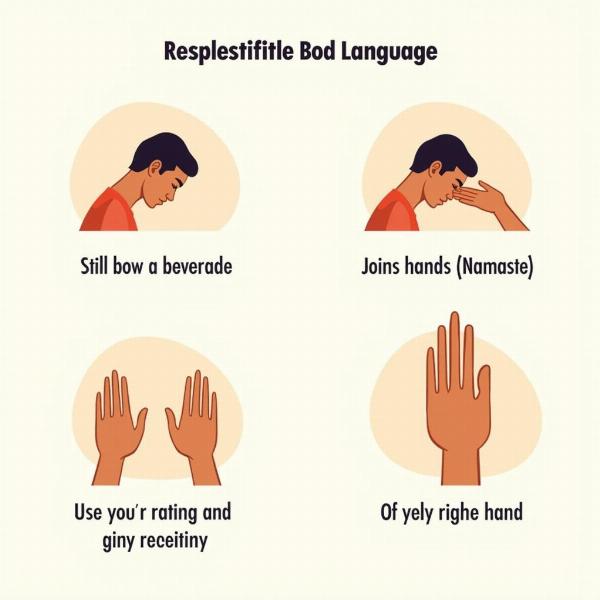Understanding the nuances of polite requests in Hindi is crucial for effective communication. Whether you’re navigating a business deal, interacting with family, or simply ordering food, knowing how to say “kindly request” in Hindi can significantly enhance your interactions. This guide explores the various ways to express “kindly request meaning in hindi,” delving into the cultural context and offering practical examples.
Different Ways to Express “Kindly Request” in Hindi
Hindi offers a rich vocabulary for making polite requests, each with its own subtle connotations. Choosing the right phrase depends on the context and your relationship with the person you’re addressing. Here are some common options:
-
कृपया (Kripya): This is the most common and versatile equivalent of “please” or “kindly.” It’s appropriate for most situations, both formal and informal. For instance, “कृपया पानी दीजिये (Kripya paani deejiye)” means “Please give me water.”
-
ज़रा (Zara): This word adds a touch of informality and is often used when asking for a small favor or reminding someone of something. “ज़रा इधर आइए (Zara idhar aaiye)” translates to “Could you come here for a moment?”
-
बिनती है (Binti hai): This phrase signifies a more earnest request, often implying humility and respect. It’s suitable for formal situations or when asking for a significant favor. “आपसे बिनती है कि आप मेरी मदद करें (Aapse binti hai ki aap meri madad karen)” means “I humbly request you to help me.”
-
अनुरोध है (Anurodh hai): Similar to “binti hai,” this phrase conveys a formal and respectful request. “आपसे अनुरोध है कि आप इस पर विचार करें (Aapse anurodh hai ki aap is par vichar karen)” translates to “I request you to consider this.”
-
मेहरबानी करके (Meherbani karke): This translates to “by your kindness” and is used to express gratitude in advance for the anticipated favor. “मेहरबानी करके दरवाजा बंद कर दीजिए (Meherbani karke darwaza band kar deejiye)” means “Kindly close the door.”
Cultural Context of Polite Requests in Hindi
Indian culture places a strong emphasis on respect and politeness, especially towards elders and those in positions of authority. Using appropriate language for requests is crucial for building positive relationships. The use of honorifics like “ji” (जी) and “aap” (आप) further enhances politeness.
Practical Examples of “Kindly Request” in Hindi
Let’s see how these phrases can be used in different scenarios:
-
At a restaurant: “कृपया मुझे मेनू दीजिये (Kripya mujhe menu deejiye)” (Kindly give me the menu).
-
Asking for directions: “ज़रा बताइए, रेलवे स्टेशन कहाँ है? (Zara bataiye, railway station kahan hai?)” (Could you tell me where the railway station is?).
-
Requesting a favor from a colleague: “अनुरोध है कि आप मुझे इस प्रोजेक्ट में मदद करें (Anurodh hai ki aap mujhe is project mein madad karen)” (I request you to help me with this project).
-
Talking to an elder: “बिनती है कि आप मुझे आशीर्वाद दें (Binti hai ki aap mujhe aashirwad den)” (I humbly request your blessings).
How to Choose the Right Phrase
While all these phrases convey politeness, choosing the right one depends on the situation and your relationship with the other person. Using “zara” with a senior could be perceived as disrespectful, while using “binti hai” for a small favor might sound overly formal. Observing how native Hindi speakers communicate will help you develop a better understanding of these nuances.
Beyond the Words: Body Language and Tone
In addition to the words you choose, your body language and tone of voice also play a significant role in conveying politeness. Maintaining eye contact, using a gentle tone, and incorporating appropriate gestures can further enhance the effectiveness of your request.
Conclusion
Mastering the art of making polite requests in Hindi involves understanding the nuances of different phrases and the cultural context in which they are used. By choosing the appropriate words and incorporating respectful body language, you can navigate social interactions with grace and build stronger relationships. Understanding “kindly request meaning in hindi” is more than just vocabulary; it’s a key to effective communication in the Indian context.
FAQ
- What is the most common way to say “please” in Hindi? Kripya (कृपया) is the most common and versatile way to say “please.”
- Is “zara” appropriate to use with elders? It’s generally best to avoid using “zara” with elders as it can be perceived as informal.
- What does “binti hai” imply? “Binti hai” implies a more earnest and humble request.
- How can I improve my understanding of polite language in Hindi? Observing native speakers and practicing different phrases in context will help you develop a better understanding.
- Why is politeness important in Indian culture? Politeness is highly valued in Indian culture as a sign of respect and consideration.
- What is the meaning of “meherbani karke”? “Meherbani karke” translates to “by your kindness” and expresses gratitude in advance.
- How does body language contribute to politeness in Hindi? Respectful body language, such as maintaining eye contact and using a gentle tone, enhances the politeness of your request.
 Body Language and Politeness in Indian Culture
Body Language and Politeness in Indian Culture
About Meaning-Hindi.in
Meaning-Hindi.in is your trusted partner for accurate and culturally sensitive Hindi translation services. We specialize in a wide range of translation solutions, including business and commercial documents, legal and certified translations, technical manuals, website localization, educational and academic materials, and express translation services. Our expert team understands the nuances of the Hindi language and ensures that your message is conveyed effectively while respecting cultural sensitivities. Contact us today for all your Hindi translation needs. Email: [email protected], Phone: +91 11-4502-7584. Let Meaning-Hindi.in help you bridge the language gap and achieve your communication goals.